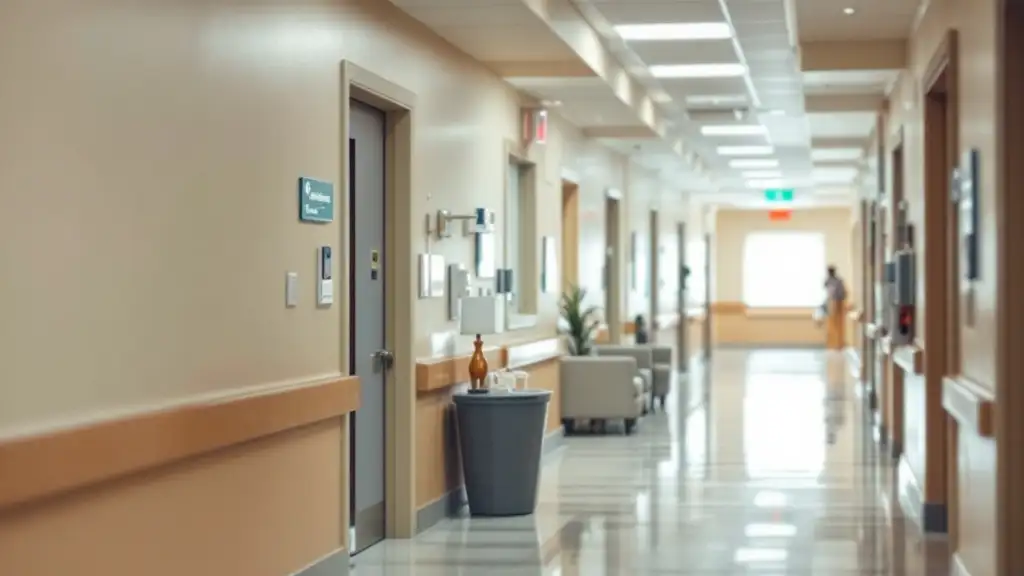Understanding the Intersection of Mental Health and Fall Prevention
Falls represent a significant public health challenge, particularly among populations with complex health needs. While physical risk factors for falls have been extensively studied and addressed, the critical role of mental health in fall prevention programs is gaining recognition. Mental illness and addiction often coexist and can exacerbate physical vulnerabilities, making integrated treatment approaches essential. This article explores how comprehensive behavioral health strategies, therapies, medication management, and community-based interventions contribute to more effective fall prevention efforts, ultimately supporting improved quality of life and reduced healthcare costs.
Comprehensive Treatment Services: A Foundation for Fall Prevention

What are comprehensive treatment services for substance abuse and mental health issues?
Comprehensive treatment services are designed to address mental health and substance use disorders in an integrated and holistic way. They combine medical, psychological, and social interventions to meet individual patient needs across multiple dimensions.
Integration of mental health and substance abuse treatment
Since nearly half of individuals with mental health disorders also face addiction, integrated treatment is essential. Rather than treating these issues separately, combined care targets root causes and reduces relapse risk effectively. Approaches include concurrent therapies for both conditions, improving outcomes and quality of life.
Range of therapies and medical interventions
Treatment modalities include evidence-based therapies such as Cognitive Behavioral Therapy (CBT), Dialectical Behavior Therapy (DBT), and Motivational Interviewing (MI), which are especially effective for co-occurring conditions. Medication-Assisted Treatment (MAT) employs FDA-approved drugs like methadone and buprenorphine to stabilize brain chemistry and manage withdrawal symptoms.
Support systems and relapse prevention
Aftercare programs offering ongoing therapy, peer support groups like AA or NA, and holistic practices such as yoga, meditation, and nutritional counseling foster long-term recovery. Trauma-informed care further helps by addressing underlying trauma that can drive substance use. These components emphasize sustained support and accountability crucial for relapse prevention.
Together, comprehensive treatment services blend medical detox, behavioral therapies, medication, and continuous support. This integrated approach helps individuals overcome the complex challenges of mental illness and addiction, promoting lasting recovery and improved functional outcomes.
Addressing Dual Diagnosis: Mental Health and Addiction in Fall Risk Populations
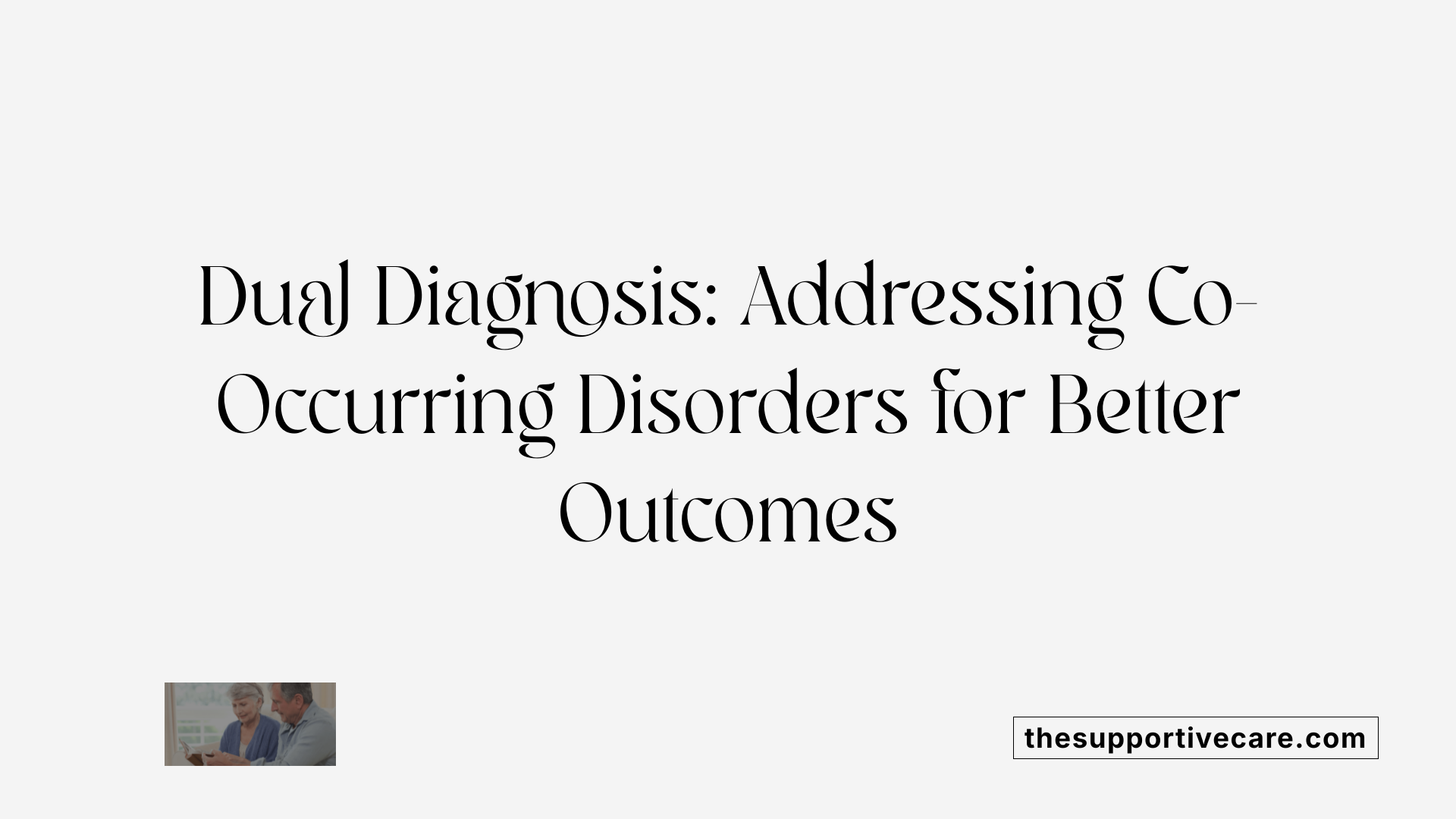
How prevalent are co-occurring mental health and addiction disorders?
Nearly half of individuals with mental health disorders also experience substance use disorders, highlighting the widespread nature of co-occurring conditions. This overlap, often called dual diagnosis, affects treatment outcomes and requires careful and comprehensive care to address the complex needs of these individuals.
What challenges arise when treating mental health and addiction separately?
Traditionally, mental health and addiction treatments were offered independently, which often led to poor long-term results. Treating these conditions separately can cause fragmented care, increase risks of relapse, and fail to address how the disorders influence each other. Without coordinated treatment, symptoms of one condition may worsen the other, leaving many patients caught in a cycle of repeated hospitalizations and ineffective interventions.
How do integrated treatment approaches improve outcomes?
Integrated treatment combines mental health and addiction care into a unified approach that simultaneously addresses both conditions. These programs use evidence-based therapies such as Cognitive Behavioral Therapy (CBT), Dialectical Behavior Therapy (DBT), and Motivational Interviewing (MI), along with Medication-Assisted Treatment (MAT) using FDA-approved medications like methadone and buprenorphine.
By treating mental illness and substance use together, integrated methods directly target the root causes of co-occurring disorders, substantially reducing relapse risk. Trauma-informed care is also a common component, providing a supportive environment to address trauma's impact on addiction and mental health.
How do treatment programs address both mental health issues and addiction simultaneously?
Treatment programs employ comprehensive assessment tools to detect co-occurring disorders and develop individualized plans. These plans often integrate psychotherapy, medication management, behavioral interventions, and peer support. Coordination between mental health and addiction treatment providers ensures continuous, seamless care.
Implementing integrated models involves training providers to understand the interplay of disorders, adopting person-centered practices, and using evidence-based protocols. Such care improves engagement, patient satisfaction, and recovery sustainability. Facilities with specialized programs and accreditation tend to offer the most effective integrated services.
| Aspect | Traditional Separate Treatment | Integrated Treatment Approach |
|---|---|---|
| Treatment focus | Single disorder at a time | Concurrent treatment of mental health and addiction |
| Therapies utilized | Vary by disorder; often isolated | Combined evidence-based psychotherapy and medication |
| Risk of relapse | Higher due to fragmented care | Reduced by addressing all conditions together |
| Patient outcomes | Often inconsistent and short-term | Improved engagement, fewer hospitalizations, better quality of life |
Integrated approaches represent the future of caring for patients with co-occurring disorders, especially in vulnerable populations at risk of falls and other complications associated with behavioral health challenges.
Therapeutic Modalities Supporting Fall Prevention in Behavioral Health
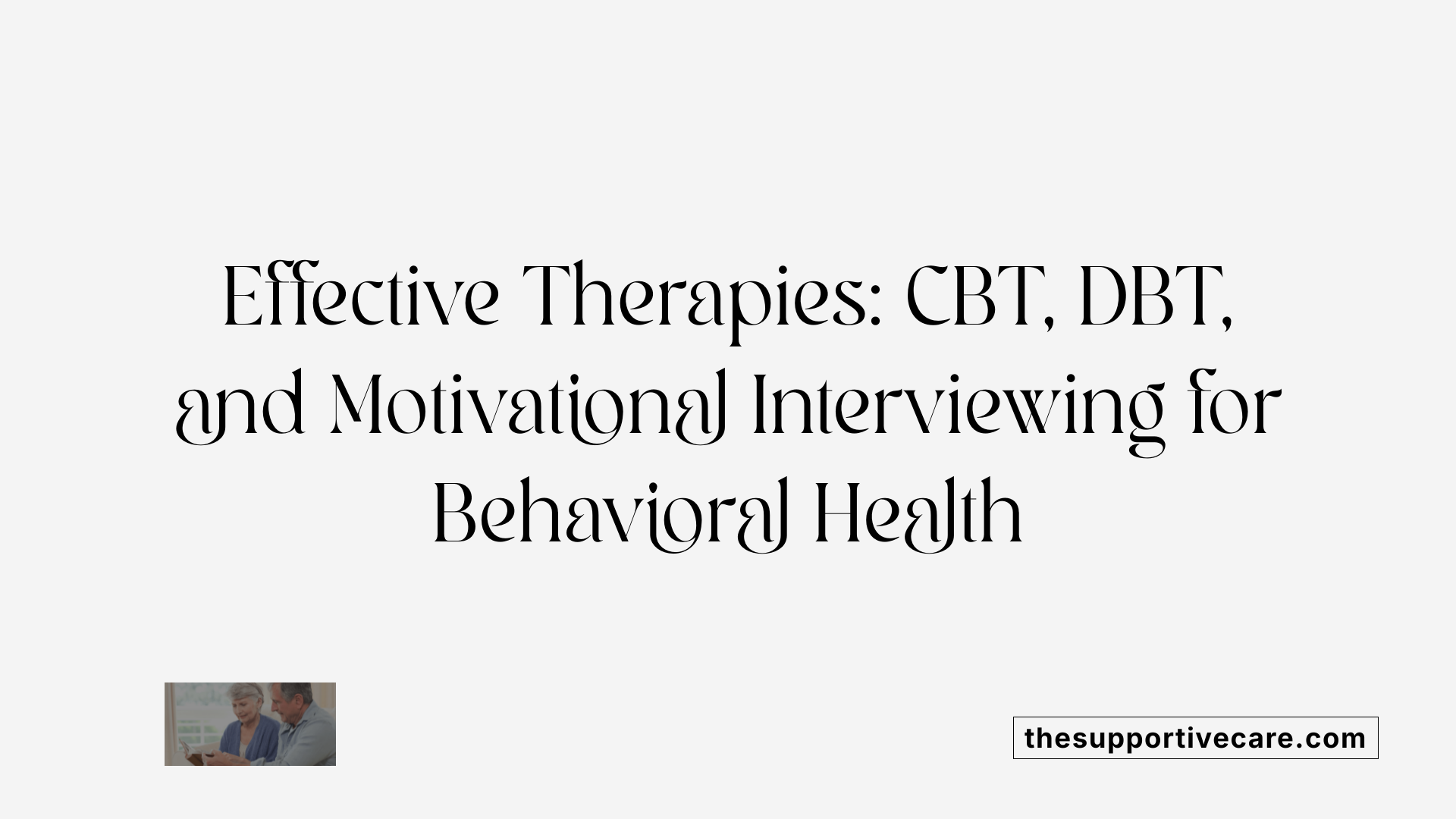
What types of therapies are commonly used in addiction and mental health treatment?
Behavioral health treatment often relies on several well-established therapies to support recovery and prevent relapse. Cognitive Behavioral Therapy (CBT) is a central approach that helps individuals recognize and change negative thought patterns and behaviors that contribute to addiction and mental health struggles. Dialectical Behavior Therapy (DBT) builds on CBT by integrating mindfulness strategies to improve emotional regulation and stress tolerance, making it particularly effective for people with co-occurring disorders.
Motivational Interviewing is another key therapy focusing on enhancing a person’s own motivation to pursue change. It serves as a collaborative conversation style that strengthens commitment to recovery goals. These therapies often work best when part of an integrated treatment plan addressing both mental illness and addiction together.
Role of family and group therapies
Family therapy and group therapies play a crucial role in behavioral health by fostering strong support networks and improving communication dynamics. Family therapy addresses interpersonal relationships that may influence substance use or mental health symptoms, helping families to support recovery efforts. Group therapies provide peer support and shared experiences, contributing to feelings of connection and accountability, which are vital for sustained recovery.
Support groups such as Alcoholics Anonymous (AA) and Narcotics Anonymous (NA) exemplify effective group-based interventions that create lasting community ties and provide ongoing encouragement to prevent relapse.
Incorporation of holistic approaches
Holistic treatments complement traditional therapies by targeting overall well-being beyond symptoms alone. Techniques like yoga, meditation, acupuncture, and nutritional counseling help manage stress, improve physical health, and foster mind–body balance. Such approaches offer meaningful outlets for coping and promote resilience, essential for long-term behavioral health.
By combining evidence-based therapies like CBT, DBT, and Motivational Interviewing with family and group support and holistic practices, treatment programs can address the complexities of behavioral health conditions. This personalized, multi-faceted method supports recovery and helps reduce the risk of relapse over time.
Medication’s Crucial Role in Behavioral Health and Fall Risk Management

What role does medication play in treating substance abuse and mental health disorders?
Medications are essential tools in managing both substance use disorders and mental health conditions. Medication-Assisted Treatment (MAT) utilizes FDA-approved drugs like methadone, buprenorphine, and naltrexone to stabilize brain chemistry. These medications reduce cravings and manage withdrawal symptoms, thereby improving recovery chances and reducing relapse rates.
Beyond substance abuse, medications effectively address mental health symptoms such as depression and anxiety. They help restore chemical balance in the brain, allowing patients to engage more fully with behavioral therapies. This dual focus is vital since nearly half of individuals with mental health disorders also struggle with addiction.
Integrating medications with psychotherapy and support services creates a comprehensive approach. Such treatment has been shown to increase retention in care, improve quality of life, and lower the risk of relapse. It supports the long-term recovery journey by addressing the biological roots of addiction and mental illness.
Impact on relapse prevention and overall recovery
The combination of medication and behavioral therapy significantly reduces relapse likelihood. MAT blocks euphoric effects of substances or eases withdrawal discomfort, enabling patients to focus on rebuilding their lives. Meanwhile, mental health medications stabilize mood and cognitive function, which are often disrupted by substance abuse.
This multi-faceted approach also supports aftercare, providing ongoing symptom management and improving patients’ ability to maintain sobriety. When paired with peer support groups and trauma-informed care, medications contribute to holistic wellness, enhancing resilience against future stressors.
| Type of Medication | Purpose | Role in Recovery |
|---|---|---|
| Methadone and Buprenorphine | Opioid dependence treatment | Reduces cravings and withdrawal symptoms |
| Naltrexone | Blocks opioid and alcohol effects | Prevents relapse by diminishing substance rewards |
| Acamprosate and Disulfiram | Alcohol dependence management | Supports prolonged abstinence |
| Antidepressants and Anxiolytics | Treat mental health symptoms like depression and anxiety | Stabilizes mood to enhance therapy engagement |
In summary, medication is not just a supportive element but a foundational component of effective behavioral health treatment. By targeting the neurochemical aspects of addiction and mental illness, medications help bridge patients toward sustained recovery and improved life quality.
Relapse Prevention as a Pillar of Sustainable Fall Prevention Programs

Why is relapse prevention important in addiction recovery programs?
Relapse prevention is a cornerstone of successful addiction recovery because relapse often occurs as a gradual process encompassing emotional, mental, and physical stages. Recognizing these early warning signs allows individuals to intervene promptly and avoid a full relapse.
Coping strategies and psychological tools
Effective relapse prevention relies on developing coping mechanisms such as mindfulness, self-care, and honest communication, which help individuals manage common triggers like stress, cravings, and environmental cues. Cognitive Behavioral Therapy (CBT) and other evidence-based therapies reinforce these skills by enhancing self-efficacy and resilience.
Personalized relapse prevention plans
Creating individualized plans that consider personal risk factors and life circumstances ensures that the strategies employed are tailored for effectiveness. Personalized relapse plans often incorporate support group involvement, medication-assisted treatment when appropriate, and trauma-informed care principles. This comprehensive approach provides ongoing support and preparedness for the challenges faced in substance recovery.
Implementing relapse prevention within behavioral health programs not only supports sustained sobriety but also improves overall quality of life by empowering individuals to manage setbacks constructively. By embedding these practices into community and clinical settings, recovery journeys become more resilient and adaptive in the long term.
Mental Health’s Influence on Fall Risk: Cognitive and Emotional Factors

How cognitive impairments increase fall risk
Cognitive impairments, such as difficulties with attention, memory, and executive function, play a significant role in increasing an individual's risk of falls. These impairments can affect a person's ability to recognize hazards, make quick decisions, or maintain awareness of their environment, contributing to unsafe movements. For example, slowed reaction times and poor judgment can delay balance corrections, making falls more likely.
Mental illness and its effect on balance and coordination
Certain mental illnesses, including depression, anxiety, and schizophrenia, have been shown to affect balance and coordination negatively. Symptoms like psychomotor slowing or restlessness, medication side effects, and reduced physical activity can weaken muscle strength and impair motor control. This diminished coordination can compromise stability during walking or standing, elevating the chances of falls.
Stress, anxiety, and depression influencing physical safety
Emotional states such as stress, anxiety, and depression further influence physical safety by affecting concentration and increasing muscle tension. High stress can lead to distracted or hurried movements, while anxiety might cause hesitation or gait changes that destabilize posture. Depression is often linked to decreased motivation for physical activity and poorer self-care, resulting in weaker physical condition and reduced balance control, which collectively heighten fall risk.
Understanding how cognitive and emotional factors contribute to falls emphasizes the need for integrated behavioral health care that addresses these risks. Incorporating mental health treatment strategies that promote cognitive clarity, emotional balance, and physical wellness can improve safety and overall quality of life for individuals facing mental health challenges.
Community-Based Behavioral Health Interventions Enhancing Fall Prevention

What is the role of community organizations in prevention and early identification?
Community-based organizations play a crucial role in delivering prevention and early identification services for behavioral health. These organizations operate in non-specialized settings, making mental health and substance use disorder services more accessible to diverse populations. By offering evidence-based behavioral health services, they detect and address issues early, potentially preventing more severe complications such as falls related to cognitive impairment or medication side effects.
How do home visits and multilingual services contribute?
Offering services in multiple languages and through home visits ensures that behavioral health care reaches underserved populations who may face linguistic or mobility barriers. Home visits allow professionals to assess environmental risks that may contribute to falls, provide tailored support, and build trusting relationships within communities. Multilingual communication enhances understanding and engagement, further reducing barriers to effective prevention and management.
How do these interventions reduce hospitalizations and improve quality of life?
Community-based behavioral health programs focused on prevention and early treatment reduce the need for hospitalization by addressing issues before they escalate. They improve patients' quality of life by supporting mental and physical health in familiar settings. By integrating fall risk factors into behavioral health assessments, such programs can decrease fall incidence and associated injuries, lowering healthcare costs and enhancing well-being.
| Intervention Aspect | Description | Impact on Fall Prevention and Behavioral Health |
|---|---|---|
| Community Early Identification | Detecting mental health and substance use problems early in accessible settings | Prevents deterioration that can increase fall risk |
| Multilingual Services | Delivering care in patients' languages to overcome communication barriers | Improves adherence to prevention strategies and treatment |
| Home Visits | Providing care and risk assessment in patients' homes | Identifies environmental fall hazards and offers tailored interventions |
| Evidence-Based Practices | Using proven therapeutic approaches and interventions | Enhances treatment outcomes and reduces hospitalization rates |
These community-centered interventions create a proactive support network that not only addresses behavioral health needs but also plays an essential role in fall prevention through early detection, personalized care, and accessible services within the community.
Telehealth: Expanding Access to Mental Health Care in Fall Prevention

Effectiveness of Telehealth for Behavioral Health Treatment
Telehealth has become a vital tool in delivering behavioral health services effectively. For many mental health conditions, virtual care offers an accessible alternative to in-person visits, reducing barriers related to transportation, stigma, and geographical limitations. Studies have demonstrated that telehealth can support therapies such as Cognitive Behavioral Therapy (CBT) and Motivational Interviewing (MI), which are effective in treating mental health and addiction issues. Its flexible nature allows continuous engagement and monitoring, which is crucial for managing chronic behavioral health conditions that can increase fall risk in vulnerable populations.
Regulatory Changes Post-COVID-19
The COVID-19 pandemic prompted significant regulatory adjustments that broadened telehealth availability nationwide. These changes included easing restrictions on cross-state licensure, expanding reimbursable services, and allowing more healthcare providers to deliver virtual care. Such shifts have led to a sustained increase in telehealth use for behavioral health care, suggesting that these expanded services will continue beyond the pandemic. This regulatory momentum supports permanent integration of telehealth into behavioral health systems, improving access for underserved communities who face challenges in obtaining in-person care.
Role of Virtual Care in Managing Behavioral Health Conditions Contributing to Falls
Many individuals at risk for falls also contend with mental illness or substance use disorders that affect balance, cognition, and mobility. Telehealth's role extends beyond treatment delivery to monitoring patients’ mental health status remotely and providing timely interventions before crises occur. Virtual platforms enable outreach and follow-up, essential for maintaining treatment adherence and addressing co-occurring conditions such as depression and addiction. By improving behavioral health management, telehealth indirectly contributes to fall prevention by stabilizing symptoms that might otherwise increase fall risk, particularly among older adults and those with complex health needs.
Decriminalization and Behavioral Health Crisis Intervention’s Role in Fall Prevention

How Does Criminalization Affect Mental Health and Substance Abuse?
Criminalizing behavioral health conditions often results in high incarceration rates among individuals with mental illness and substance use disorders. This approach does not address the root causes of these conditions and frequently exacerbates health problems by limiting access to appropriate care. Furthermore, the stress and instability caused by incarceration can increase the risk of falls, injuries, and other adverse health outcomes, particularly for vulnerable populations.
What Benefits Do Mobile Crisis Teams and Diversion Programs Offer?
Mobile crisis teams and diversion programs provide specialized, community-based responses to behavioral health emergencies. These programs emphasize de-escalation and immediate support, reducing the need for hospitalizations and incarceration. Evidence shows these interventions improve mental health outcomes and decrease healthcare costs. By managing crises proactively, they help prevent physical harm, including falls caused by untreated agitation or psychiatric distress.
How Can Decriminalization Reduce Incarceration and Improve Behavioral Health Outcomes?
Decriminalizing behavioral health conditions shifts the focus from punitive measures to treatment and support. Development of crisis response systems that include mobile crisis teams allows law enforcement to collaborate with healthcare professionals, reducing arrests related to mental illness and substance use. This approach not only decreases incarceration rates but also facilitates timely behavioral health care, improving quality of life and reducing fall-related injuries among affected individuals.
| Aspect | Impact | Role in Fall Prevention |
|---|---|---|
| Criminalization | High incarceration, worsens health, limits treatment access | Increased fall risk due to inadequate care |
| Mobile Crisis Teams | Rapid response, de-escalate crises, reduce hospitalizations | Prevent falls from psychiatric distress and agitation |
| Diversion Programs | Redirect from jail to care, lower costs, better outcomes | Decrease injury risk by reducing incarceration stress |
| Decriminalization Efforts | Shifts approach from punishment to support and treatment | Enhances access to care, lowering fall and injury rates |
Addressing Social Determinants to Mitigate Behavioral Health Risks and Falls
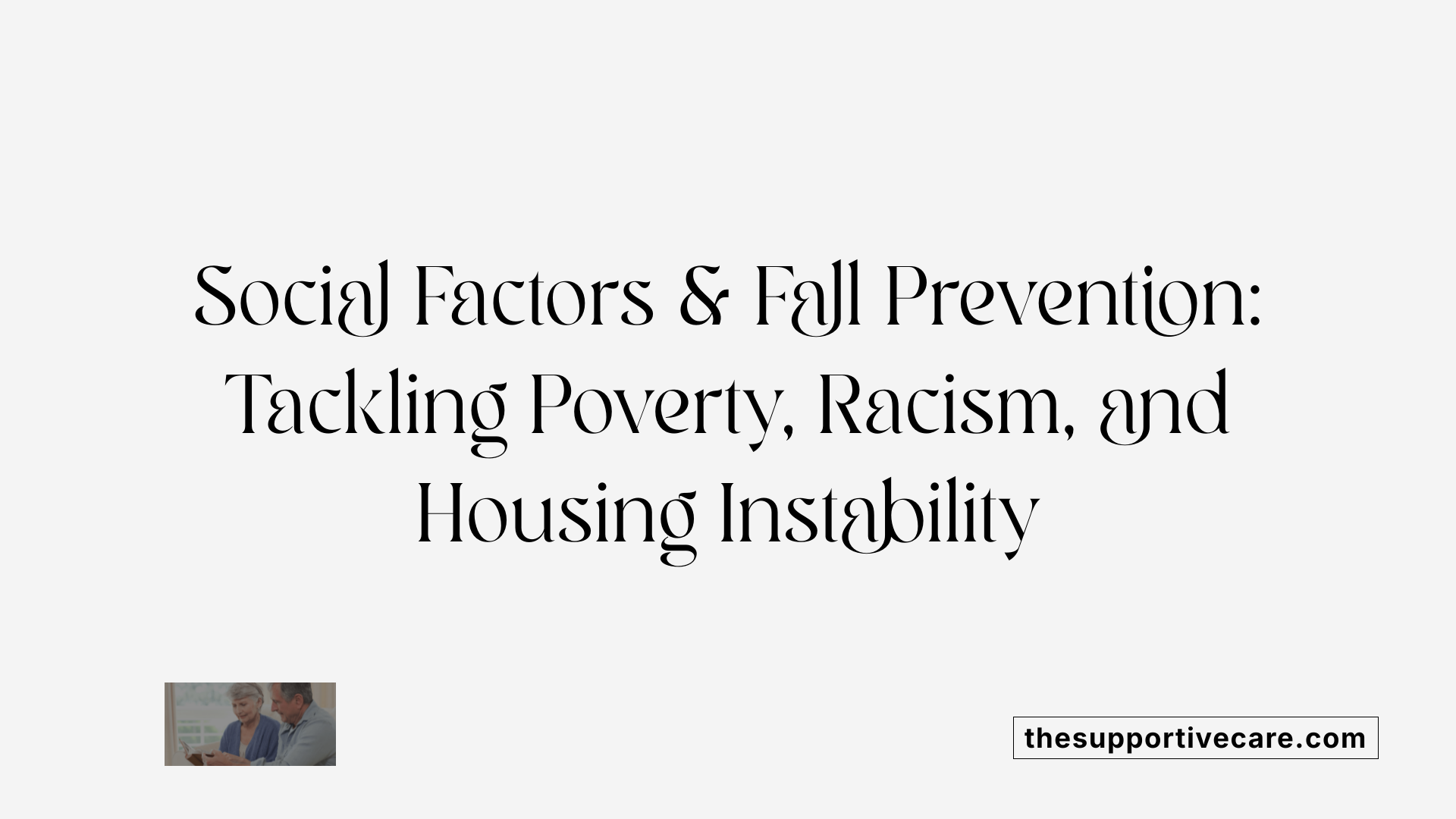
How do poverty and systemic racism influence behavioral health?
Poverty and systemic racism profoundly affect behavioral health outcomes by creating chronic stress and limiting access to necessary resources. Economic insecurity often leads to increased exposure to violence and reduced access to quality healthcare, worsening mental illness and substance use disorders. Structural racism compounds these challenges by perpetuating disparities across marginalized communities, including people of color and youth.
Why are affordable housing and employment crucial for behavioral health?
Affordable housing and stable employment form the foundation for healthier lives by providing security and reducing stressors that contribute to behavioral health problems. Lack of safe housing can exacerbate mental health symptoms and substance misuse, while unemployment increases vulnerability to addiction and psychological distress. Policies promoting housing access and job opportunities help break this cycle and promote recovery.
How can early childhood interventions reduce behavioral health disparities?
Early childhood interventions target risk factors before behavioral health conditions develop, offering long-term benefits. Programs that support social and emotional skills in young children decrease future substance use and mental health issues. By focusing on at-risk communities and integrating culturally sensitive approaches, these interventions reduce disparities caused by social determinants and improve quality of life from an early age.
Workforce Investments: Training Providers for Integrated Fall Prevention Care
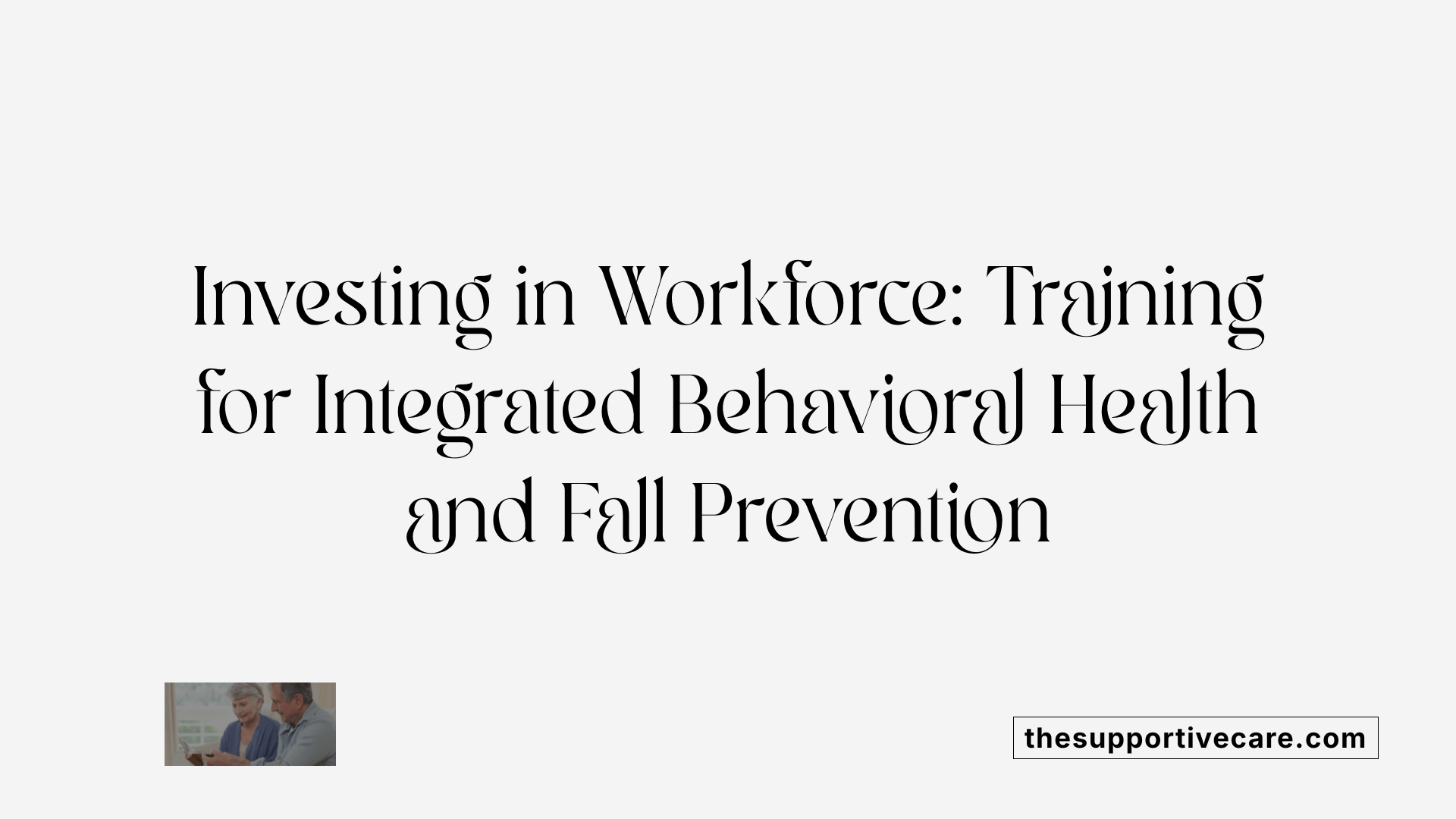
Diversifying the Behavioral Health Workforce
Expanding the behavioral health workforce to include diverse providers is vital. A workforce that reflects the communities served fosters trust, improves communication, and enhances treatment relevance. Diverse providers are better positioned to address cultural nuances and barriers that patients may face, thus improving engagement and adherence in fall prevention care.
Training on Social Determinants and Structural Competency
Effective provider training now extends beyond clinical skills. Understanding social determinants of health—such as poverty, housing instability, and systemic racism—is essential for addressing the root causes of behavioral health issues related to falls. Structural competency training equips providers to recognize and respond to systemic factors that impact patients' health outcomes, enabling more holistic and equitable care.
Enhancing Accessibility and Quality of Care
Investing in workforce development improves both accessibility and quality. Trained providers skilled in integrated care methods can deliver comprehensive prevention programs that incorporate behavioral health and physical safety. This reduces unmet needs and improves patient outcomes by offering interventions in community settings and via telehealth. Ultimately, such workforce investments create a more responsive and effective system for fall prevention and behavioral health management.
Outcome Measurement Beyond Service Use: Functional and Quality-of-Life Indicators
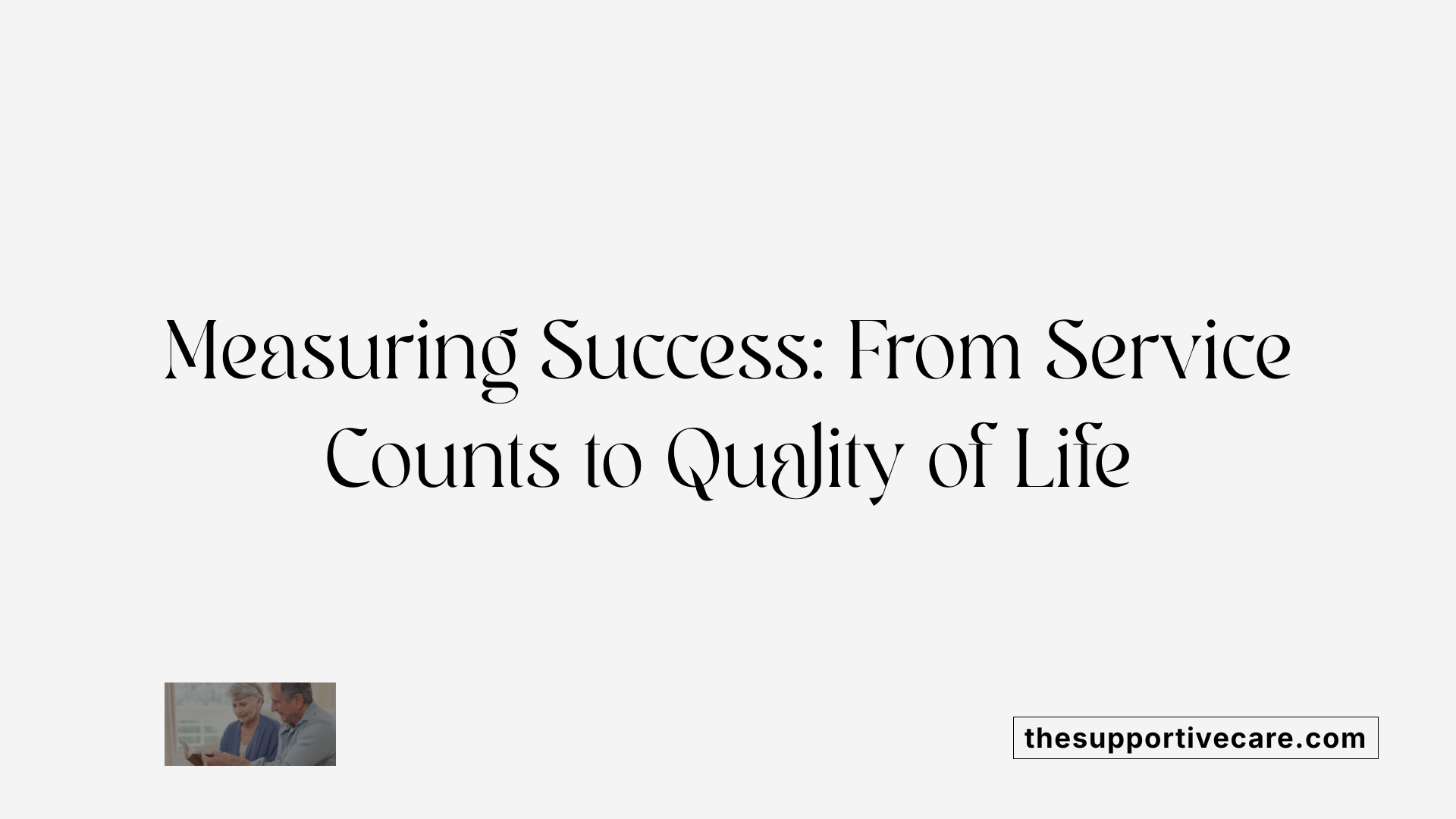
Why Measure Effectiveness Beyond Service Use?
Traditional evaluations of behavioral health and fall prevention programs often emphasize service utilization — such as the number of hospital visits or treatment sessions. However, these metrics alone provide an incomplete picture. Measuring effectiveness solely through service use overlooks the actual impact on a person’s daily functioning and overall well-being, which are critical to understanding true recovery and prevention success.
Focusing on Quality of Life and Functional Outcomes
Modern outcome measurement prioritizes functional indicators and quality-of-life metrics. These include improvements in daily living skills, social engagement, emotional stability, and physical independence. For example, reductions in relapse rates or fewer hospitalizations are important, but equally vital is assessing whether individuals regain meaningful roles in work, family, and community.
Functional outcomes also capture the real-world impact of integrated behavioral health treatments, such as combining mental health and addiction care, or community-based and telehealth services. By tracking quality-of-life changes, providers can tailor interventions to support long-term recovery rather than short-term symptom management.
Informing Policy and Clinical Practice
Data on functional and quality-of-life outcomes inform policymakers on which programs deliver lasting benefits and optimal resource use. Clinicians use this information to refine treatment plans, emphasizing holistic approaches that address both health conditions and social determinants like housing, employment, and social support.
Outcome measurement that encompasses these indicators supports the shift toward recovery-oriented systems, where success is defined by sustained improvement in individuals' lives, not just service metrics. Ultimately, this approach drives more person-centered care and evidence-based policies that better meet the complex needs of people experiencing behavioral health challenges.
Prevention Strategies Targeting Youth and Families to Reduce Behavioral Health Risks

What School-Based Evidence-Based Programs Help Reduce Behavioral Health Risks?
Several well-established programs aim to reduce behavioral health risks among youth by promoting social and emotional skills. Programs like Life Skills Training and Too Good for Drugs are specifically designed for K-12 students. They focus on developing critical skills such as managing emotions, resisting peer pressure, and making healthy decisions, which directly address the risk factors for substance use and mental illness.
How Do Early Intervention Services Support Youth Behavioral Health?
Early intervention services such as Teen Intervene and Screening, Brief Intervention, and Referral to Treatment (SBIRT) play an important role in reducing substance use among youth. Teen Intervene operates primarily in school settings and uses motivational interviewing techniques to engage youth early. SBIRT is mainly used in healthcare settings and identifies at-risk individuals to provide timely interventions. Both services have demonstrated effectiveness not only in lowering substance use but also in reducing associated depressive symptoms.
How Can Risk Factors for Substance Use and Mental Illness Be Reduced?
Preventing behavioral health problems involves addressing community, school, and family risk factors. School programs improve social skills and emotional regulation, while early interventions catch problems before they worsen. Additionally, community strategies—such as liquor store compliance checks, alcohol server training, and social host regulations—modify the social and economic conditions influencing substance access. Together, these efforts contribute to lowering the development of substance use disorders and related mental health issues in youth.
| Strategy | Target Group | Key Features/Benefits |
|---|---|---|
| Life Skills Training | K-12 students | Builds social skills, emotional management |
| Too Good for Drugs | K-12 students | Promotes drug resistance and healthy choices |
| Teen Intervene | At-risk youth in schools | Early motivational intervention |
| SBIRT | Youth in healthcare settings | Screening and brief intervention for risk |
| Community Compliance Measures | Community | Limits youth access to alcohol, reduces exposure |
These prevention strategies collectively provide a comprehensive approach to reduce behavioral health risks among youth and families, supporting healthier developmental trajectories.
Integrated Care Models: Linking Primary, Mental Health, and Substance Abuse Services for Fall Prevention
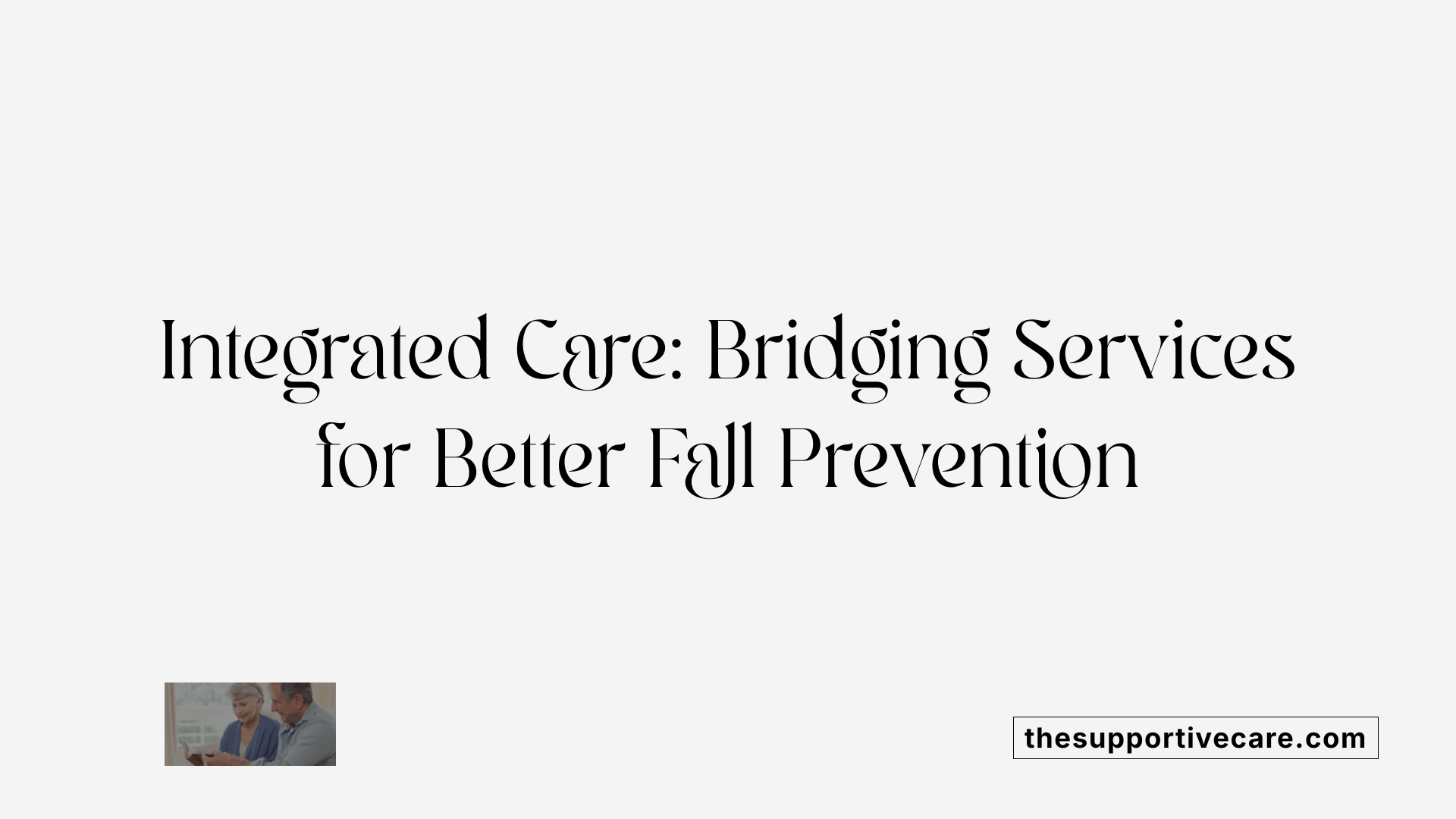
What are the benefits of care coordination for patients with co-occurring disorders?
Integrated care models provide seamless coordination between primary care, mental health, and substance use disorder (SUD) services. For patients experiencing both mental illness and addiction, this comprehensive approach ensures that all aspects of their health are addressed simultaneously. Coordinated care improves diagnosis accuracy and tailors treatment plans to the individual's complex needs, reducing the risk of relapse and enhancing long-term recovery. It also facilitates ongoing monitoring, helping to catch early signs of deterioration that could lead to falls or other health complications.
How does integrated care improve treatment access and appointment adherence?
Linking services into a centralized or distributive network streamlines patient navigation through the healthcare system. Patients benefit from 'one-stop shopping' models where they can receive medical, behavioral, and addiction services in one setting, minimizing barriers to care. This ease of access leads to higher rates of appointment adherence as transportation challenges and scheduling difficulties are reduced. Additionally, integrated care systems often provide staff training in substance use and mental health, fostering an environment in which patients feel supported and understood, which further encourages consistent engagement.
In what ways does integrated care reduce service duplication and lower healthcare costs?
By coordinating care across different specialties, integrated models avoid redundancy, such as repeated diagnostic tests or conflicting medications. This efficiency decreases overall healthcare expenditures, easing the financial burden on both patients and the system. Moreover, better management of co-occurring disorders through integrated care reduces hospitalization rates and emergency visits, leading to substantial cost savings. From a societal perspective, these models improve health outcomes and reduce the strain on various separate services by consolidating treatment pathways.
| Aspect | Impact of Integrated Care | Examples/Details |
|---|---|---|
| Care Coordination | Addresses mental health and substance use disorders together | Tailored treatment, relapse prevention, functional improvement |
| Treatment Access & Adherence | Simplifies healthcare navigation and boosts engagement | One-stop clinics, staff trained in co-occurring disorders |
| Cost Reduction & Efficiency | Avoids duplicate services, lowers hospital utilization | Fewer emergency visits, coordinated medication management |
Barriers and Opportunities in Coordinating Behavioral Health and Fall Prevention Services

What Stigma and Financial Disincentives Hinder Integration?
Stigma remains a significant barrier in linking behavioral health with other health services, including fall prevention programs. Many professionals view substance abuse treatment as separate from mainstream medical care, which perpetuates this divide. Financial disincentives also play a role, as limited reimbursement and unclear funding pathways reduce providers’ motivation to coordinate care effectively. Confidentiality concerns further complicate collaboration across specialties, making it harder to share essential patient information.
How Do Training Gaps Among Healthcare Professionals Affect Linkage?
Healthcare providers often lack sufficient training to recognize and address behavioral health conditions, especially in contexts like fall prevention where such issues may be overlooked. Without adequate mental health and addiction education, professionals are less equipped to screen, refer, or manage these interconnected problems. This training gap contributes to missed opportunities for earlier intervention and comprehensive care.
What Innovations Support Better Diagnostic and Treatment Linkage?
Recent advances in diagnostic tools and pharmacological and behavioral treatments have created new opportunities for improved integration. Screening tools like the Modified Mini and models such as Health Homes enhance early detection and coordination between physical, mental, and substance use disorder care. Regulatory changes expanding telehealth use also enable broader access, allowing more seamless service delivery. These innovations provide a promising foundation to overcome existing barriers through policy reforms and workforce development.
| Barrier/Challenge | Impact on Integration | Emerging Opportunities |
|---|---|---|
| Stigma and Perception | Limits referral and collaboration between fields | Increased awareness and recovery-oriented care |
| Financial Disincentives | Reduces provider participation in holistic care | Advocacy for reimbursement reforms |
| Training Deficiencies | Lowers screening and management of comorbidities | Workforce development with social determinants focus |
| Confidentiality Concerns | Restricts information sharing among services | Updated regulations enabling secure communication |
| Diagnostic and Treatment Gaps | Delayed or fragmented care | Enhanced screening tools and integrated models |
Addressing these barriers through concerted policy, education, and technological innovation can help align behavioral health and fall prevention services, ultimately improving patient outcomes and reducing systemic inefficiencies.
Peer Support and Recovery-Oriented Care: Sustaining Gains and Preventing Falls

Role of peer recovery coaches
Peer recovery coaches play a vital role in sustaining behavioral health gains by offering lived-experience support to individuals navigating recovery from mental illness and substance use disorders. These coaches provide relatable guidance, encouragement, and accountability, creating a bridge between professional care and daily life challenges. Their involvement is especially significant for individuals with co-occurring disorders, who benefit from personalized empowerment grounded in empathy and practical knowledge.
Recovery Month and public awareness
Recovery Month serves as an annual public awareness campaign dedicated to celebrating individuals in recovery and promoting access to recovery resources. It emphasizes the ongoing nature of recovery, educating communities and reducing stigma around behavioral health conditions. By highlighting stories of resilience and the importance of long-term support, Recovery Month fosters societal acceptance and underscores the value of recovery-oriented services and peer support systems.
Long-term support and empowerment for individuals with co-occurring disorders
Recovery-oriented care focuses on a long-term, person-centered journey that empowers individuals with co-occurring mental health and addiction challenges to maintain their recovery. This includes continuous access to therapeutic services, peer support, and skill-building aimed at preventing relapse. The holistic approach recognizes recovery as more than symptom reduction—it promotes quality of life, self-efficacy, and social integration over time, effectively reducing the risk of falling back into behavioral health crises.
Moving Forward: Embedding Mental Health into Fall Prevention Programs
The integration of mental health treatment and behavioral health strategies into fall prevention programs is not merely beneficial—it is essential. Addressing co-occurring disorders through comprehensive, integrated care enhances both mental and physical health outcomes while reducing relapse and fall risk. Community-based services, telehealth expansion, crisis intervention, social determinants recognition, and workforce training collectively form a robust framework that supports individuals holistically. Moving beyond traditional models to emphasize functional outcomes, prevention, and peer-supported recovery will further strengthen fall prevention efforts. As healthcare systems evolve, embedding mental health deeply within fall prevention represents a critical step towards safer, healthier communities and improved quality of life for vulnerable populations.
References
- Transforming Mental Health And Addiction Services
- Treating Mental Health to Combat Relapse in Addiction ...
- Prevention, Treatment, and Recovery in Substance Use ...
- Benefits of Linking Primary Medical Care and Substance ...
- Mental health and substance use services
- Integrated Treatment of Substance Use and Psychiatric ...
- Integrating Treatment for Co-Occurring Mental Health ...




































































